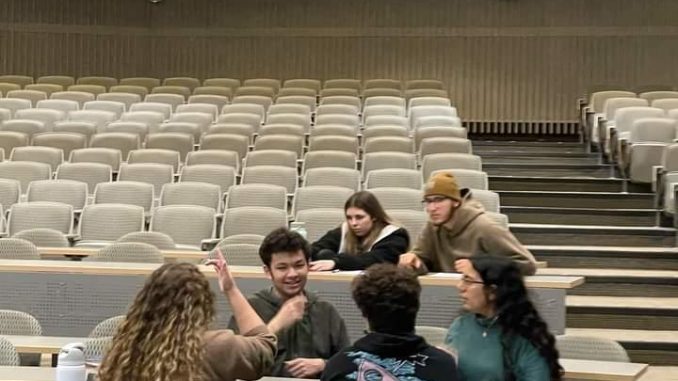
American Sign Language is present in every realm of life: education, business, human services and government. It is the third most commonly used language in the United States, aside from English and Spanish. It’s a natural language that is expressed by employing both hand configuration, motion trajectory, facial expressions and posture.
Last Monday, the ASL club at SUNY New Paltz hosted a Halloween-themed poetry night in the Lecture Center, room 100.
The night started off with some examples of poems from famous Deaf poets as well as an informational presentation about what ASL is. “Historically, it has been used as a medium for expression just like traditional poetry, but instead of expressing emotions and ideas through vocal inflection, Deaf poetry is expressed visually through facial expressions,” public relations manager Agya Owusu-Fordjour, a second-year sociology major with minors in Deaf and Black studies said. One of the poems was by Clayton Valli, “a prominent ASL poet who was a big influence on our event since he was one of the foremost innovators of modern ASL poetry,” Owusu-Fordjour added. “He was a professor of linguistics and interpreting at Gallaudet University and a proponent of showing the legitimacy of ASL as a language and the validity of ASL poetry. It’s such an important part of Deaf culture and history so we wanted to make sure we represented it with this event.”
After this introduction, club members and attendees were allowed some space in groups to create any kind of poem they wanted, keeping the Halloween theme in mind, until they were ready to present their work. Chatter and laughter filled the room. People clustered themselves into groups, with their heads down, creating pieces.
Members Brynn Andrews, a first-year English major with a concentration in creative writing and a minor in Deaf studies and Josie Shea performed their original story about getting lost in a pumpkin patch and attacked by a scarecrow: “Last week we went to a farm. We walked through many rows of corn. Orange pumpkins were all around the ground. We found an entrance to a corn maze. I asked you, ‘Do you want to go in?’ You said ‘yeah.’ We entered the maze together and walked along the path. It got dark. We couldn’t see and got scared. It got very cold and we didn’t know which way to go. Suddenly, a scarecrow appeared! The scarecrow attacked us and we screamed! We died. The end.”
“I loved the expression on the line ‘rows of corn, we don’t know which way to go’ that Josie signed because her acting was so great,” Andrews said. “ASL has incredible poetry because of the facial expressions and movement you’re able to add to the story, which makes it more emotional and interesting.”
Andrews also recognized that “we live in a hearing world and Deaf individuals never deserve to be left out. I think this club does a good job of teaching others to be more inclusive. I’ve made a lot of good friends through it.”
Tess Robbin, a fourth-year communication disorders major with a minor in Deaf studies and the president of the ASL club, agreed, “It’s important for people to learn about the Deaf and hard-of-hearing community because often people have preconceived notions that are false. This event shows how Deaf individuals are just as capable of creating beautiful and meaningful art without spoken words.”
Seeing how widely used and misunderstood it is, having some understanding of the ASL language and hearing loss, deafness and Deaf culture is key to being able to communicate with Deaf people at a basic level and to be more inclusive and connected in today’s world.
Especially given the rising demand for ASL skills in the modern workforce and the increasing environment of awareness of inclusivity, diversity and connection, the ASL club has a fundamental place on campus. Employment of sign language interpreters and translators is projected to grow 4% from 2022 to 2032.
“Since Deaf studies is one of the most popular minors at SUNY New Paltz, this club gives students a chance to practice their signing skills with their peers, learn some new signs and participate in fun activities,” Robbin said. “The club is open to students of all levels. You do not need any experience at all to join. We want to make sure we are an inclusive club that welcomes everyone.”
The club is highly involved in the local community, working to spread this message. The E-board will be visiting a Kingston elementary school on Nov. 17th to teach introductory signs to Pre-K through fourth grade.
Other future events that incorporate learning new signs and about the Deaf culture and community, run by the New Paltz ASL club include a Deaf culture Kahoot night collaboration with National Student Speech Language Hearing Association, Audiology Club and Multicultural United Students Empowered on Thursday, Nov. 16. There’s also an ASL game night on Monday, Nov. 27 and an E-board election meeting on Dec. 11, as many seniors will be graduating at the end of the semester. Each of these will be in LC 100 from 8-9 p.m.
